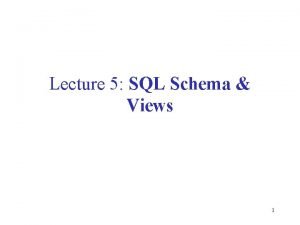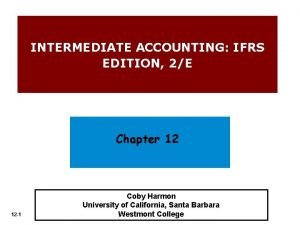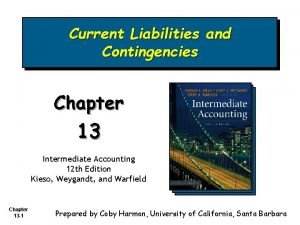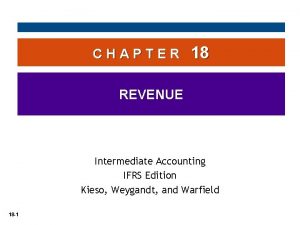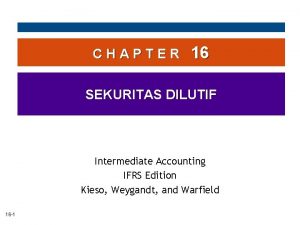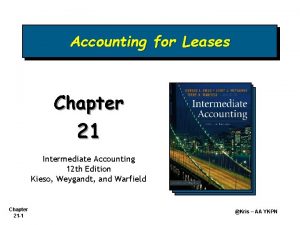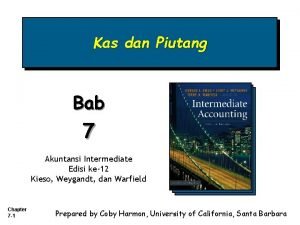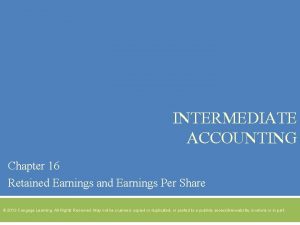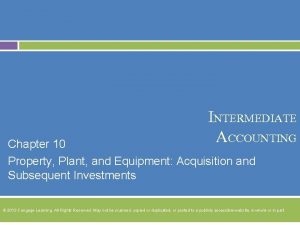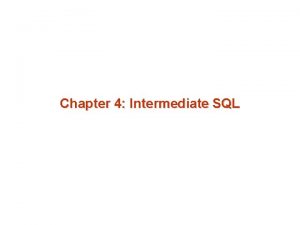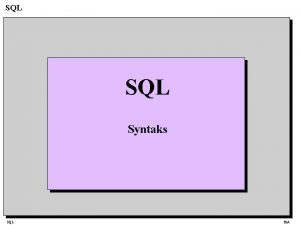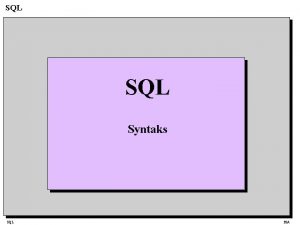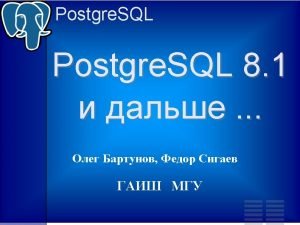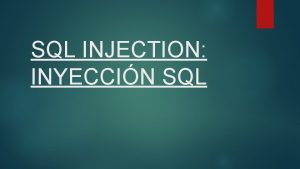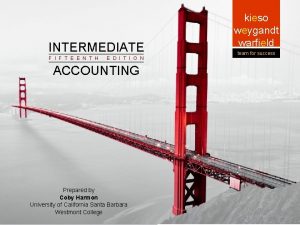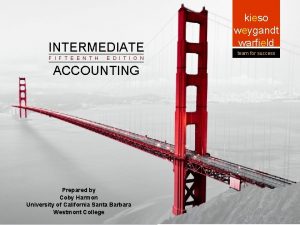Chapter 4 Intermediate SQL Views Views n In













- Slides: 13

Chapter 4: Intermediate SQL Views

Views n In some cases, it is not desirable for all users to see the entire logical model (that is, all the actual relations stored in the database. ) n Consider a person who needs to know an instructors name and department, but not the salary. This person should see a relation described, in SQL, by select ID, name, dept_name from instructor n A view provides a mechanism to hide certain data from the view of certain users. n Any relation that is not of the conceptual model but is made visible to a user as a “virtual relation” is called a view.

View Definition n A view is defined using the create view statement which has the form create view v as < query expression > where <query expression> is any legal SQL expression. The view name is represented by v. n Once a view is defined, the view name can be used to refer to the virtual relation that the view generates. n View definition is not the same as creating a new relation by evaluating the query expression l Rather, a view definition causes the saving of an expression; the expression is substituted into queries using the view.

Example Views n A view of instructors without their salary create view faculty as select ID, name, dept_name from instructor n Example using view l Find all instructors in the Biology department select name from faculty where dept_name = ‘Biology’ n Create a view of department salary totals create view departments_total_salary(dept_name, total_salary) as select dept_name, sum (salary) from instructor group by dept_name;

Views Defined Using Other Views n create view physics_fall_2009 as select course_id, sec_id, building, room_number from course, section where course_id = section. course_id and course. dept_name = ’Physics’ and section. semester = ’Fall’ and section. year = ’ 2009’; n create view physics_fall_2009_watson as select course_id, room_number from physics_fall_2009 where building= ’Watson’;

View Expansion n Expand use of a view in a query/another view create view physics_fall_2009_watson as (select course_id, room_number from (select course_id, building, room_number from course, section where course_id = section. course_id and course. dept_name = ’Physics’ and section. semester = ’Fall’ and section. year = ’ 2009’) where building= ’Watson’;

Views Defined Using Other Views n One view may be used in the expression defining another view n A view relation v 1 is said to depend directly on a view relation v 2 if v 2 is used in the expression defining v 1 n A view relation v 1 is said to depend on view relation v 2 if either v 1 depends directly to v 2 or there is a path of dependencies from v 1 to v 2 n A view relation v is said to be recursive if it depends on itself.

View Expansion n A way to define the meaning of views defined in terms of other views. n Let view v 1 be defined by an expression e 1 that may itself contain uses of view relations. n View expansion of an expression repeats the following replacement step: repeat Find any view relation vi in e 1 Replace the view relation vi by the expression defining vi until no more view relations are present in e 1 n As long as the view definitions are not recursive, this loop will terminate

Materialized Views n Materializing a view: create a physical table containing all the tuples in the result of the query defining the view n If relations used in the query are updated, the materialized view result becomes out of date l Need to maintain the view, by updating the view whenever the underlying relations are updated.

Update of a View n Add a new tuple to faculty view which we defined earlier insert into faculty values (’ 30765’, ’Green’, ’Music’); n Two alternatives: l This insertion is represented by the insertion of the tuple (’ 30765’, ’Green’, ’Music’, null) into the instructor relation l Or, issue an error message and reject the insertion

Some Updates Cannot Be Translated Uniquely n create view instructor_info as select ID, name, building from instructor, department where instructor. dept_name= department. dept_name; n insert into instructor_info values (’ 69987’, ’White’, ’Taylor’); n Now what? n which department, if multiple departments in Taylor? n what if no department is in Taylor?

What Do DBMS Do? n Most SQL implementations allow updates only on simple views l The from clause has only one database relation. l The select clause contains only attribute names of the relation, and does not have any expressions, aggregates, or distinct specification. l Any attribute not listed in the select clause can be set to null l The query does not have a group by or having clause. n Updatable Views

And Some Not at All n create view history_instructors as select * from instructor where dept_name= ’History’; n What happens if we insert (’ 25566’, ’Brown’, ’Biology’, 100000) into history_instructors?
 Types of views in sql
Types of views in sql Difference between sql and plsql
Difference between sql and plsql Pl/sql unit testing
Pl/sql unit testing Chapter 15 intermediate accounting
Chapter 15 intermediate accounting Kieso chapter 17
Kieso chapter 17 Amortization expense formula
Amortization expense formula Accounting for current liabilities and contingencies
Accounting for current liabilities and contingencies Intermediate accounting chapter 18
Intermediate accounting chapter 18 Intermediate accounting chapter 16
Intermediate accounting chapter 16 Kieso intermediate accounting chapter 21 solutions
Kieso intermediate accounting chapter 21 solutions Chapter 19 accounting for income taxes
Chapter 19 accounting for income taxes Chapter 7 cash and receivables solutions
Chapter 7 cash and receivables solutions A restriction/appropriation of retained earnings
A restriction/appropriation of retained earnings Intermediate accounting chapter 10
Intermediate accounting chapter 10
